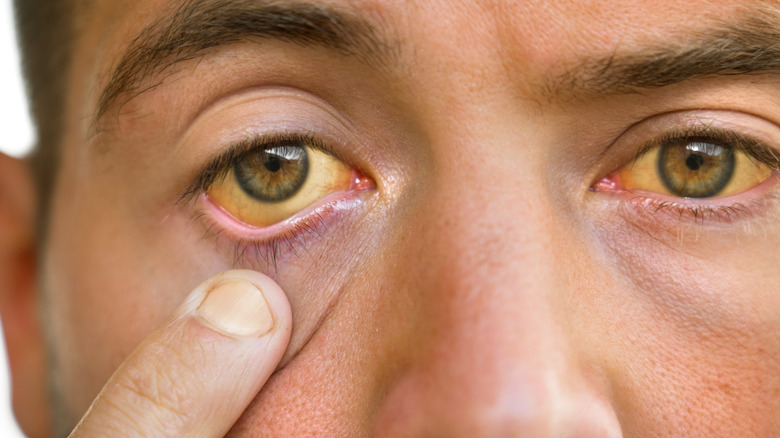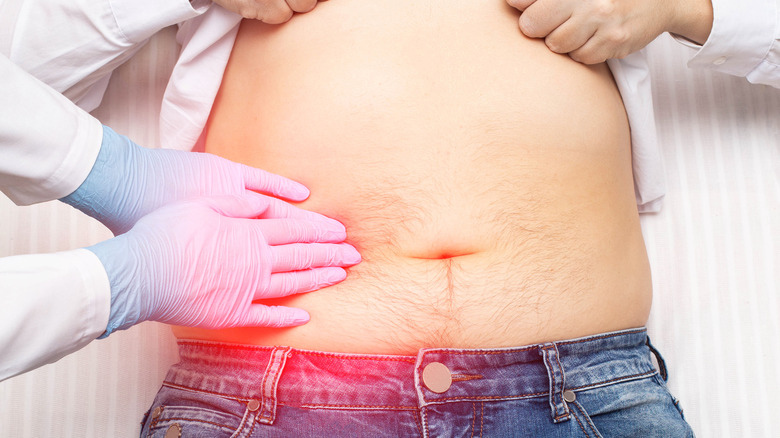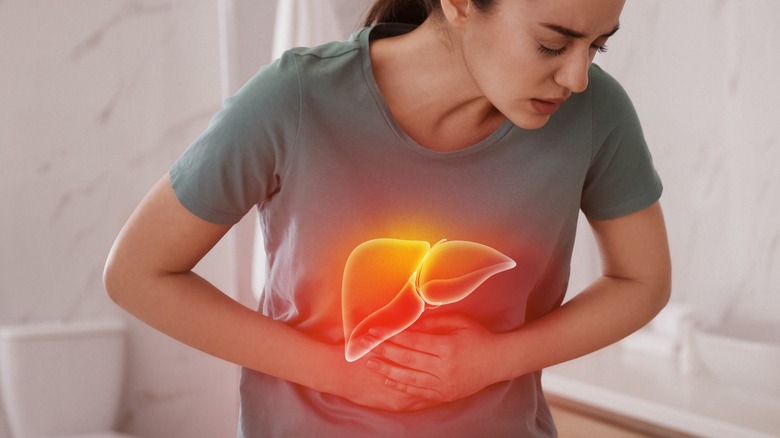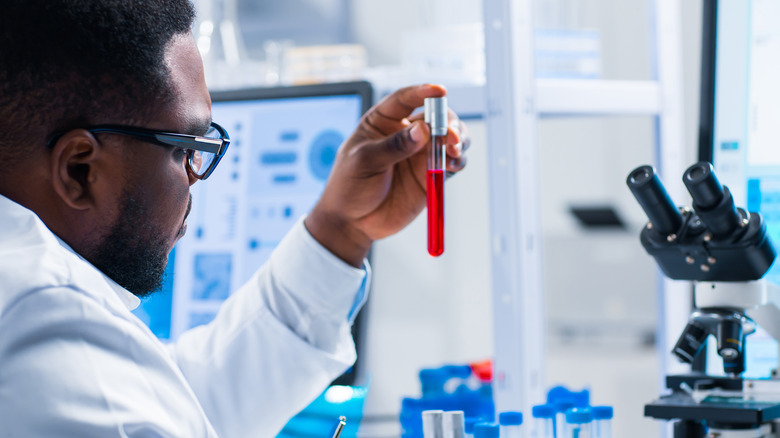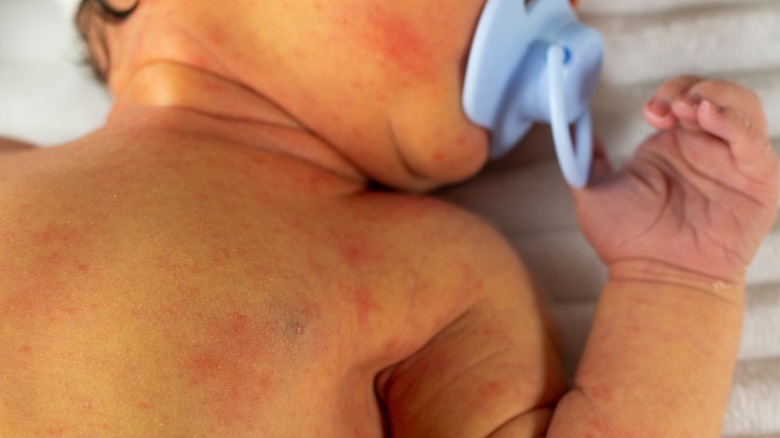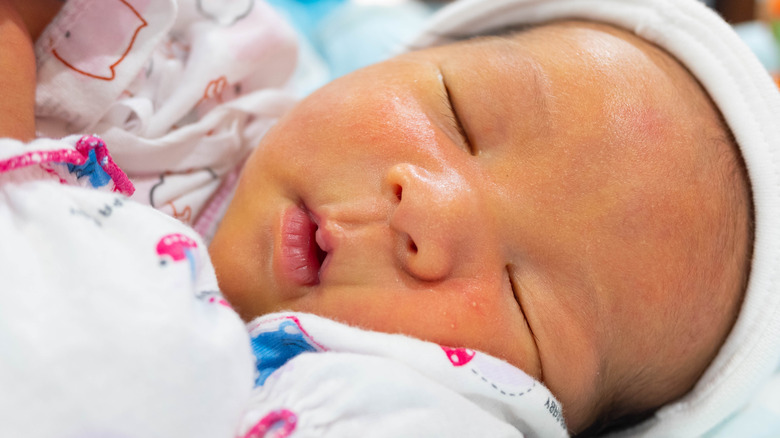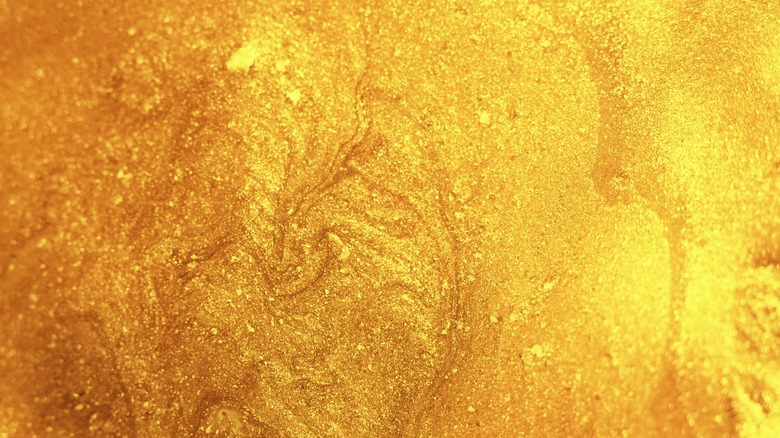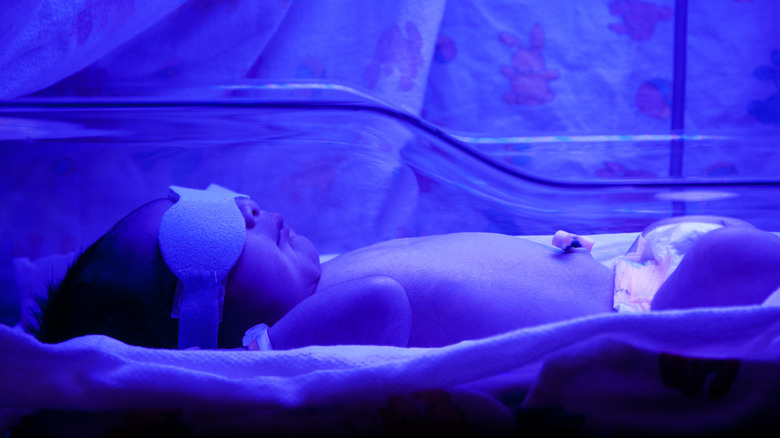Jaundice Explained: Causes, Symptoms, And Treatments
When you notice a sudden color change in your (or your child's) skin, eyes, and urine, you may get worried. Possible reasons include heavy consumption of alcohol, viral health issues (like hepatitis A, B, and C), uncommon genetic-linked issues with metabolism, and autoimmune diseases (per Medicover Hospitals). But after observing the issue for some time and noting that the problem is only getting worse, you may try to handle it on your own based on the (likely) limited information you may have about it.
There are many popular myths and misconceptions around jaundice. One claims that a single treatment approach, light therapy, treats all types of jaundice — and you may think that saving up for the therapy and getting you or your child under the artificial light will help (via The Health Site). However, since jaundice is a health issue and a symptom for other hidden health problems, you may end up getting disappointed if the cause of the jaundice type you have requires another treatment approach.
Having correct and complete information about jaundice can help you understand the type of jaundice you or your child may have based on the symptoms, the risks involved, and the best treatment options. It'll also save you time and perhaps even some money in the long run. Here's everything you should know about jaundice — all the information you need to help you take the right course of action.
Reasons why jaundice occurs
Jaundice is brought about by the formation of an extremely high amount of a yellow substance known as bilirubin in the blood after red blood cells disintegrate (per the National Health Service). When formed, bilirubin finds its way to your liver, where it's converted and combined with other waste products in the body. Then, it gets taken out of the body through the anus. This process runs smoothly when there's a moderate amount of bilirubin in your body. However, your liver tends to have a harder time with converting higher amounts of bilirubin, which paves the way for jaundice.
MedlinePlus notes that the occurrence of jaundice is usually an indicator that your pancreas, liver, or gallbladder (a tiny sac located below the liver) is experiencing issues. You may have a pancreatic tumor, gallstones, gallbladder cancer, or gallbladder inflammation (via the Cleveland Clinic). Other reasons why you may develop jaundice are if your liver gets overwhelmed by bilirubin, if your red blood cells rupture and then camp in the liver, or if the bilirubin in your liver doesn't get into the alimentary canal — the extended pathway for food which includes the esophagus, gut, and intestines — as expected (per MedlinePlus).
The Cleveland Clinic further explains that jaundice may also arise before bilirubin's formation, especially when a massive blood clot below your skin gets reabsorbed or when your red blood cells rupture and immediately get disposed of before they are even due.
Jaundice risk factors
According to the Mayo Clinic, several factors increase children's risk of developing jaundice, including premature birth. If a baby is born earlier than around nine months after conception, trouble with bilirubin conversion and combination with stool may occur. And since a prematurely born baby eats and defecates less, bilirubin may not entirely get removed from the body as it normally should, increasing the chances of developing jaundice.
Race is also another key factor. Medical experts have found that babies from East Asian countries have higher chances of getting jaundice. The Archives of Pediatrics and Adolescent Medicine says that East Asian babies have more elevated levels of bilirubin compared to white babies and babies with a mixed background of half-white and half-Asian parents.
The Mayo Clinic also explains that when a baby sustains injuries while being born, high quantities of red blood cells disintegrate to help with wound healing, a process that may result in spiked levels of bilirubin. Plus, if a baby has trouble feeding, jaundice may be a likely after-effect due to reduced food intake and dehydration. Moreover, passing antibodies to the unborn child via the placenta may result in a blood type that's different from the mother. These antibodies cause an unusually fast red blood cell disintegration that may make jaundice more likely to happen. Winchester Hospital adds that for adults, common risk factors for jaundice include alcohol addiction, drug abuse, using medication that has a negative impact on the liver, and having hepatitis A, B or C.
Diseases that heighten the risk for jaundice
If you have certain diseases, especially in areas like your liver cells, red blood cells, and the bile ducts found inside and around the liver, you're likely to get jaundice (per Patient). In the liver cells, several issues such as a poor uptake of bilirubin, malfunction of liver cells' enzymes, bilirubin transportation to bile ducts, and decreased count of actively functioning liver cells are common. These problems may lead to conditions like liver cirrhosis, alcoholic hepatitis, medication-caused or poison-caused liver inflammation, and bacterial infections. MedlinePlus also mentions parasitic infections as a possible jaundice risk factor affecting the liver.
Conditions targeting red blood cells like malaria, haemolytic uraemic syndrome, and genetic conditions like spherocytosis (where your red blood cells appear spherical as opposed to looking like a disk) and sickle cell anemia may unnecessarily boost the destruction rate for the red blood cells, and may increase bilirubin levels in your body. This may, in turn, make it hard for the liver to attend to the additional bilirubin.
Moreover, health problems like primary sclerosing cholangitis (where scarring and inflammation of your bile ducts occurs) may constrict or destroy the small bile ducts in your liver, limiting the movement of the digestive fluid known as bile. If the bile consists of bilirubin and it gets into the blood, it causes jaundice. The same case applies to the common bile duct which the small bile ducts pour into. Conditions like pancreatitis, gallstones, and pancreatic cancer constrict the common bile duct and trigger jaundice (via Patient).
Jaundice types
Healthline lists four main types of jaundice: Pre-hepatic, hepatic, post-hepatic, and neonatal jaundice. Beginning with pre-hepatic jaundice, this type has characteristics like unusual weight loss, abdominal pain, itchiness, dark-colored urine, or light-colored feces. If you live in or go to areas with a reputation for malaria, take harmful drugs a lot, or even have a close relative with blood problems, you may get pre-hepatic jaundice. Hepatic jaundice comes with symptoms like vomiting, decreased desire for food, joint and muscle pain, general weakness, a sickly feeling, and your skin developing a darker shade. If you are a heavy drug or alcohol user, are taking acetaminophen or other heart medications, or have a history of liver infections, you may get hepatic jaundice.
Post-hepatic jaundice has similar symptoms to pre-hepatic and hepatic jaundice. However, the risk factors differ quite a bit. You stand higher chances of developing post-hepatic jaundice if you are a person with diabetes mellitus, advanced in age, or a woman. The same applies if you take plenty of alcohol, someone in your family had or still has gallstones, you had an inflammation in your pancreas, you have obesity or consume fatty food with less fiber, or you interact with chemicals used by industries. Lastly, neonatal jaundice is the type of jaundice that is frequently observed in recently born babies.
Jaundice and children
The Boston Children's Hospital estimates that babies born full-term have a 50% chance of developing jaundice around the first seven days after birth, while those born before the 36th week of pregnancy have an 80% chance.
Babies may have one of the five forms of neonatal jaundice: breast-milk, physiological, hemolysis-based jaundice, inadequate liver function, and breastfeeding jaundice. Breast-milk jaundice is the form that's often brought about by breast milk content that allows bilirubin reabsorption in the baby's intestines, or when the liver isn't developed well enough to process the bilirubin. Meanwhile, physiological jaundice comes from the baby's inability to eliminate bilirubin through feces. Hemolysis-based jaundice comes from hemolysis — the condition linked to extreme red blood cell disintegration — whose cause is mainly hemorrhage, hemolytic disease, and polycythemia. Jaundice may also come from a poorly functioning liver whose impairment may have been caused by infections or other causes. Lastly, breastfeeding jaundice is a common type of jaundice in newborns a week after birth due to dehydration and poor eating abilities.
Healthline notes that some of the best preventive measures that reduce the odds of getting jaundice include keeping away from using physical objects like cups that other people that may be having a virus have already used, and maintaining high hygiene standards.
The signs and symptoms to look out for
According to Ada, skin yellowing in various body parts is the dominant jaundice symptom to watch out for. Skin yellowing will start on your face and gradually spread downward to your legs. For kids who have a darker skin tone, checking for skin yellowing may be difficult. However, a neat trick that can help with that is the skin press test, where you use one of your fingers to apply some fairly forceful push on the baby's skin and then let go. If the skin gives off a yellowish color once you remove the pressure, it's a sign of jaundice. To determine if the condition is advancing, observe the area under the baby's knees: If it's becoming more yellow by the day, it may signal the condition.
Furthermore, if the baby is experiencing challenges with eating and waking up from sleep, becoming grumpy quite often, and bending their neck (not to mention their posture appearing bent backward), that's your cue to take your baby to the doctor right away. Lybrate also mentions light-colored excrement, urine with a dark color, constantly throwing up, and color change in your eyes from their normal color to brown or orange as other jaundice symptoms.
Moreover, since jaundice may be a symptom of an undiscovered condition, looking for other symptoms known to bring about such conditions (malaria and joint pain, for instance) may help you identify the condition responsible for jaundice (per the Mayo Clinic).
Jaundice diagnosis
When diagnosing neonatal jaundice, the doctor usually focuses on your baby's physical look and bilirubin levels. Common diagnostic tests and examinations include a skin test that works with a tool called a transcutaneous bilirubinometer (via the Mayo Clinic). Your doctor places a unique medical light on your skin, and then quantifies the reflection that passes through your skin with the device's help. Other tests include physical examinations and blood tests for your baby.
Physical examination helps to identify the affected areas in your body and the specific causes of the jaundice type you're having based on the condition's pattern. Some key things kept into consideration during a physical examination include any signs of underlying conditions and your liver's size relative to your weight and height. If your liver is huge and you're showing signs of jaundice, there's a possibility you may be having neoplasm (a growth that develops inside or outside your body that's often cancerous), liver disease, or amyloidosis (where the amyloid protein increases in organs like your heart). Meanwhile, a tiny liver may show other different health issues (per Karger).
Doctors normally look for certain features in your condition to determine which type of jaundice you have. News Medical Life Sciences says that when it comes to pre-hepatic jaundice, expected characteristics include elevated insoluble bilirubin levels in your blood and a lack of bilirubin in urine. For hepatocellular jaundice, your doctor should see soluble bilirubin in your urine. Post-hepatic jaundice results in darker urine and light-colored stool.
Treatment options for jaundice
Per the National Health Service, jaundice in newborns comes and disappears in about two weeks without needing any medical intervention. This happens if the baby doesn't have a lot of bilirubin in the blood and if you keep feeding them consistently (whether it's through your breast or a bottle). When needed, you should even wake them from sleep to eat. However, if the baby's bilirubin levels are super hiked, your doctor may recommend several treatment options to keep things under control. The two most common treatment approaches are phototherapy and exchange transfusion.
In phototherapy, your child receives exposure to a special kind of light, helping the liver have a smoother breakdown and elimination of bilirubin from the blood. Regular phototherapy is flexible, and allows your baby to take feeding breaks for about half an hour while receiving treatment. Meanwhile, in intensified phototherapy, there are no breaks at all. The baby may drink expressed milk, though.
If peak levels of bilirubin persist even after phototherapy, your doctor may turn to exchange transfusion, or the replacement of your baby's blood with blood from someone with a similar blood group. The donor's blood has low bilirubin levels, so when your baby receives it, jaundice goes away pretty fast. However, this treatment may require a couple of hours. The doctor will keep checking the baby for any complications (like bleeding) and handling them as the treatment progresses. Other viable treatment methods include enhanced nutrition and intravenous immunoglobulin (via the Mayo Clinic).
Home remedies for jaundice
Healthline says it's possible to do away with symptoms of jaundice with a balanced diet, as it optimizes the health of your liver. Dehydration is one of the many reasons your liver struggles to function correctly, and keeping yourself constantly hydrated by consuming favorable amounts of coffee, tea and water can help boost liver function. Fruits and vegetables are also highly recommended in varying quantities based on the individual's weight, age, level of physical activity, gender, and height. However, at the base level, adult women should take about one and a half to two cups of fruits and about three cups of veggies every day. Meanwhile, adult men should have two to two and a half cups of fruits and around two and a half to four cups of veggies, says the Dietary Guidelines for Americans.
Also, fiber-rich foods like whole grains, legumes, and nuts can go a long way in optimizing bilirubin's movement in the body. Furthermore, you should avoid taking alcohol, fatty foods, and sugary foods. Sodium also plays a big role in determining how long body fluids remain in the body; if you take too much sodium (like by consuming canned beans, canned fruits, and canned vegetables without washing them thoroughly and draining them first), this may cause the fluids to hang around for an extended period, which may cause harm to your body. If you add too much salt to your food for more flavor, consider replacing that with oregano, garlic powder, and onion powder (per Healthline).
Why jaundice treatment is urgent
The Cleveland Clinic insists on the importance of seeking prompt medical attention for your baby when you suspect they have jaundice. This way, you can determine how severe the condition is and keep it under control with the help of a medical professional. Failing to get treatment for jaundice may bring about more serious complications like deafness, kernicterus, and cerebral palsy.
Kernicterus is an uncommon form of brain damage that's caused by extreme bilirubin levels in the baby's blood. It may also lead to the destruction of the central nervous system. Some of the most prevalent symptoms of babies with kernicterus include short breathing interruptions, the baby failing to eat or breastfeed adequately and properly, loosely hanging muscles, feeling sleepy, not having a startle reflex, being highly sensitive, and a sharp cry (via the National Health Service).
Cerebral palsy is a condition that's highlighted by brain damage or odd brain development that makes it hard for someone to have a good grip of their muscles (per Centers for Disease Control and Prevention). A paper in Tropical Medicine and Parasitology also notes that other jaundice complications may include acute renal (kidney) failure, cerebral malaria (a severe form of malaria that affects your consciousness and causes a coma and seizures), pulmonary adema (where fluids collect in your lungs and cause complications), and other extreme malaria-based issues.
Jaundice prevention
In adult jaundice, the causes vary; thus, there's no one particular way to prevent it. Several recommendations, however, can help reduce your chances of getting it. These recommendations include regulating the amount of cholesterol you ingest, steering clear of hepatitis infection, keeping your weight under control, and drinking alcohol responsibly (via the Cleveland Clinic).
Jaundice prevention in babies is also hard to do, but keeping your baby adequately fed can really help. Make sure you breastfeed your baby eight to 12 times each day for the first few days after the baby has been born. If you are working with formula feeding instead, aim for one to two ounces after every 120 to 180 minutes. Sunlight can also help regulate bilirubin levels in your baby's body, so consider sitting inside your house in spots where sunlight hits. Moreover, when you're free and the sun is out, take a walk around the neighborhood with your baby, so that they can enjoy the warmth and bilirubin-based benefit of sunlight (per Grow by WebMD).
Sunlight offers as much bilirubin regulation effect as phototherapy. However, sitting under the sun for long may carry the risk of your baby getting hyperthermia (where your baby's body gets overheated). To avoid that, let your baby enjoy the sun for about four hours every day (via Cochrane).

